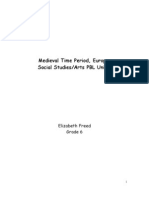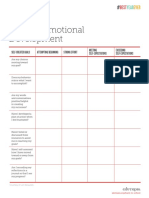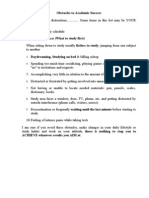Project Design Rubric Vmay2017
Project Design Rubric Vmay2017
Uploaded by
api-219303331Copyright:
Available Formats
Project Design Rubric Vmay2017
Project Design Rubric Vmay2017
Uploaded by
api-219303331Original Title
Copyright
Available Formats
Share this document
Did you find this document useful?
Is this content inappropriate?
Copyright:
Available Formats
Project Design Rubric Vmay2017
Project Design Rubric Vmay2017
Uploaded by
api-219303331Copyright:
Available Formats
P R O J E C T D E S I G N R U B R I C
Essential Lacks Features of Effective PBL Needs Further Development Includes Features of Effective PBL
Project Design The project has one or more of the following The project includes some features of The project has the
Element problems in each area: effective PBL but has some weaknesses: following strengths:
Key Knowledge, Student learning goals are not clear and The project is focused on standards- The project is focused on teaching
Understanding specific; the project is not focused on derived knowledge and understanding, students specific and important
& Success Skills standards. but it may target too few, too many, or knowledge, understanding, and skills
The project does not explicitly target, less important goals. derived from standards and central to
assess, or scaffold the development of Success skills are targeted, but there may academic subject areas.
success skills. be too many to be adequately taught and Important success skills are explicitly
assessed. targeted to be taught and assessed, such
as critical thinking/problem solving,
collaboration, and self-management.
Challenging The project is not focused on a central The project is focused on a central The project is focused on a central
Problem or problem or question (it may be more problem or question, but the level of problem or question, at the appropriate
Question like a unit with several tasks); or the challenge might be inappropriate for the level of challenge.
problem or question is too easily solved intended students. The central problem or question is
or answered to justify a project. The driving question relates to the framed by a driving question for the
The central problem or question is not project but does not capture its central project, which is:
framed by a driving question for the problem or question (it may be more like open-ended; it will allow students to
project, or it is seriously flawed, for a theme). develop more than one reasonable
example: The driving question meets some of the answer.
it has a single or simple answer. criteria (in the Includes Features column) understandable and inspiring to
it is not engaging to students (it sounds for an effective driving question, but students.
too complex or academic like it came lacks others.
aligned with learning goals; to answer it,
from a textbook or appeals only to a students will need to gain the intended
teacher). knowledge, understanding, and skills.
Sustained The project is more like an activity or Inquiry is limited (it may be brief and
Inquiry is sustained over time and
Inquiry hands-on task, rather than an extended only occur once or twice in the project; academically rigorous (students pose
process of inquiry. information-gathering is the main task; questions, gather & interpret data,
There is no process for students to deeper questions are not asked). develop and evaluate solutions or build
generate questions to guide inquiry. Students generate questions, but while evidence for answers, and ask further
some might be addressed, they are not questions).
used to guide inquiry and do not affect
Inquiry is driven by student-generated
the path of the project. questions throughout the project.
For more PBL resources, visit bie.org 2 0 17 B U C K I N S T I T U T E F O R E D U C A T I O N
Project Design Rubric / Page 2
Authenticity The project resembles traditional The project has some authentic features, The project has an authentic context,
schoolwork; it lacks a real-world but they may be limited or feel contrived. involves real-world tasks, tools, and
context, tasks and tools, does not make quality standards, makes a real impact
a real impact on the world or speak to on the world, and/or speaks to students
students personal interests. personal concerns, interests, or identities.
Student Voice Students are not given opportunities to Students are given limited opportunities Students have opportunities to express
& Choice express voice and choice affecting the to express voice and choice, generally in voice and choice on important matters
content or process of the project. less important matters (deciding how (questions asked, texts and resources
Students are expected to work too much to divide tasks within a team or which used, people to work with, products to
on their own, without adequate guidance website to use for research). be created, use of time, organization of
from the teacher and/or before they are Students work independently from the tasks).
capable. teacher to some extent, but they could do Students have opportunities to take
more on their own. significant responsibility and work as
independently from the teacher as is
appropriate, with guidance.
Reflection Students and the teacher do not engage in Students and teachers engage in some Students and teachers engage in
reflection about what and how students reflection during the project and after thoughtful, comprehensive reflection
learn or about the projects design and its culmination, but not regularly or in both during the project and after its
management. depth. culmination, about what and how
students learn and the projects design
and management.
Critique & Students get only limited or irregular Students are provided with opportunities Students are provided with regular,
Revision feedback about their products and work- to give and receive feedback about the structured opportunities to give and
in-progress, and only from teachers, not quality of products and work-in-progress, receive feedback about the quality of
peers. but they may be unstructured or only their products and work-in-progress from
Students do not know how or are not occur once. peers, teachers, and if appropriate from
required to use feedback to revise and Students look at or listen to feedback others beyond the classroom.
improve their work. about the quality of their work, but do Students use feedback about their work to
not substantially revise and improve it. revise and improve it.
Public Product Students do not make their work public Student work is made public only to Student work is made public by
by presenting it to an audience or offering classmates and the teacher. presenting or offering it to people beyond
it to people beyond the classroom. Students present products, but are not the classroom.
asked to explain how they worked and Students are asked to publicly explain the
what they learned. reasoning behind choices they made, their
inquiry process, how they worked, what
they learned, etc.
For more PBL resources, visit bie.org 2 0 17 B U C K I N S T I T U T E F O R E D U C A T I O N
You might also like
- Tina Bruce, Carolyn Meggitt, Julian Grenier - Child Care & Education-Trans-Atlantic Publications, Inc. (2010)Document579 pagesTina Bruce, Carolyn Meggitt, Julian Grenier - Child Care & Education-Trans-Atlantic Publications, Inc. (2010)Nehir CantasNo ratings yet
- English File: Grammar, Vocabulary, and PronunciationDocument15 pagesEnglish File: Grammar, Vocabulary, and PronunciationLeya STU100% (1)
- EDPS 410 Midterm PrepDocument12 pagesEDPS 410 Midterm PrepAnthony KhaNo ratings yet
- 8 Ways Teacher FlashcardsDocument8 pages8 Ways Teacher Flashcardsapi-249799367100% (1)
- Personal Curriculum PlatformDocument12 pagesPersonal Curriculum Platformsmoore9988No ratings yet
- Gable - Haidt.what Is Positive PsychologyDocument8 pagesGable - Haidt.what Is Positive PsychologyAjaan100% (3)
- Medieval Time Period, Europe Social Studies/Arts PBL Unit: Elizabeth Freed Grade 6Document31 pagesMedieval Time Period, Europe Social Studies/Arts PBL Unit: Elizabeth Freed Grade 6liz1044100% (1)
- Sample Student ProfileDocument3 pagesSample Student ProfileS TANCREDNo ratings yet
- Paetep Observation 12-5Document7 pagesPaetep Observation 12-5api-312265721No ratings yet
- EEL Continuum PrePrimaryDocument1 pageEEL Continuum PrePrimarysuji1974No ratings yet
- Educational PhilosophyDocument3 pagesEducational Philosophyapi-527571126No ratings yet
- Newsletter-Counseling 10-26-18 FrontDocument2 pagesNewsletter-Counseling 10-26-18 Frontapi-339302820No ratings yet
- Introduction To Social Dimensions of EducationDocument29 pagesIntroduction To Social Dimensions of Educationnimfa villamor100% (1)
- A Study On Academic Stress of Higher Secondary School StudentsDocument9 pagesA Study On Academic Stress of Higher Secondary School StudentsAnonymous CwJeBCAXp100% (1)
- Consensus TheoryDocument3 pagesConsensus TheoryGlenn Puralan FloresNo ratings yet
- Excel Project3Document13 pagesExcel Project3api-317201982No ratings yet
- Group Task Behaviour Management ResourceDocument53 pagesGroup Task Behaviour Management Resourceapi-220799002No ratings yet
- Avoiding Math Taboos - Effective Math Strategies For Visual-Spatial LeaDocument12 pagesAvoiding Math Taboos - Effective Math Strategies For Visual-Spatial LeaChi ColosoNo ratings yet
- 414 Management PlanDocument6 pages414 Management Planapi-643841683100% (1)
- Color Code Personality and Major Selection PosterDocument1 pageColor Code Personality and Major Selection Posterapi-282474245No ratings yet
- Educ 6 Curriculum Designing - 035853Document26 pagesEduc 6 Curriculum Designing - 035853Salvador Delos SantosNo ratings yet
- Unit Plan - Wellness 10 - Wellness and WorldviewDocument10 pagesUnit Plan - Wellness 10 - Wellness and WorldviewMarissa KnudsenNo ratings yet
- Philosophical Assumptions: Personality Psychology Is A Branch ofDocument45 pagesPhilosophical Assumptions: Personality Psychology Is A Branch ofpkatareNo ratings yet
- The Design Brief Challenge PacketDocument5 pagesThe Design Brief Challenge Packetrobinsonje1No ratings yet
- The 5 Theories of Early Years Learning FrameworkDocument7 pagesThe 5 Theories of Early Years Learning Frameworkapi-321279297No ratings yet
- Topic 3 - Areas of Science in ECDDocument13 pagesTopic 3 - Areas of Science in ECDMzee MsideeNo ratings yet
- PBL in BiologyDocument35 pagesPBL in BiologynelmianNo ratings yet
- Community Service ReflectionDocument1 pageCommunity Service Reflectionapi-479453127No ratings yet
- Food Web WorksheetDocument1 pageFood Web WorksheetkenyaNo ratings yet
- Developmental MilestonesDocument2 pagesDevelopmental Milestonesapi-339989449100% (1)
- Chapter One Teaching ProfessionDocument52 pagesChapter One Teaching ProfessionClaudette Lui Cabanos- Mercado-ReyesNo ratings yet
- IB Psychology: Internal AssessmentDocument15 pagesIB Psychology: Internal AssessmentTenzin Sonam LamaNo ratings yet
- Curriculum 2b Assessment 1Document12 pagesCurriculum 2b Assessment 1api-408493824No ratings yet
- Curriculum EvidenceDocument17 pagesCurriculum Evidenceapi-286701530No ratings yet
- OverviewDocument45 pagesOverviewJohnjohn MateoNo ratings yet
- A Handbook For Teachers About Outcome Based EducationDocument69 pagesA Handbook For Teachers About Outcome Based Educationqcqapgh7748100% (2)
- Problem Solvin Mind MapDocument7 pagesProblem Solvin Mind MapDin Aswan RitongaNo ratings yet
- Nine Steps To More Effective Parenting: 1. Boosting Your Child's Self-EsteemDocument3 pagesNine Steps To More Effective Parenting: 1. Boosting Your Child's Self-Esteemapi-522213725No ratings yet
- Geography LessonDocument4 pagesGeography Lessonapi-349671090100% (1)
- 13-6-2012-12522 Using The Tasc WheelDocument18 pages13-6-2012-12522 Using The Tasc Wheelapi-224303452No ratings yet
- For Kohlberg's Theory of Moral DevelopmentDocument15 pagesFor Kohlberg's Theory of Moral DevelopmentYuvaraj Nithyanandam100% (1)
- Edutopia Desautels Sel RubricDocument1 pageEdutopia Desautels Sel Rubricapi-290658778No ratings yet
- Assignment - Developmental TheoriesDocument7 pagesAssignment - Developmental TheoriesKewkew Azilear100% (1)
- Ms. Brekke's Counseling Calendar: August September October November DecemberDocument3 pagesMs. Brekke's Counseling Calendar: August September October November Decemberapi-372001247No ratings yet
- Gardening For Grade School Research Paper NewDocument13 pagesGardening For Grade School Research Paper Newapi-307925762100% (1)
- COM1005 Visual CompositionDocument10 pagesCOM1005 Visual CompositionmadhavithakurNo ratings yet
- Social and Emotional (SEL) Parent Survey LetterDocument2 pagesSocial and Emotional (SEL) Parent Survey LetterDana LitNo ratings yet
- What Is Gifted - Final Web EditDocument7 pagesWhat Is Gifted - Final Web Editapi-253977101No ratings yet
- 3d ProgramDocument8 pages3d Programapi-464990788No ratings yet
- Model Jean McNiffDocument8 pagesModel Jean McNiffvivimahsyNo ratings yet
- Ib Bio Skills ApplicationsDocument19 pagesIb Bio Skills Applicationsapi-330898066No ratings yet
- Toolbox NotesDocument17 pagesToolbox Notesapi-280150165No ratings yet
- Tips To Study BetterDocument4 pagesTips To Study BetterPancha BaidaNo ratings yet
- Chapter 5: Plate Tectonics: Teaching Support For Pages 180-181 Syllabus LinksDocument58 pagesChapter 5: Plate Tectonics: Teaching Support For Pages 180-181 Syllabus LinksGaayathiriNo ratings yet
- Fcs 359 Lesson Plan 2Document2 pagesFcs 359 Lesson Plan 2api-384129594No ratings yet
- Holocaust PBLDocument6 pagesHolocaust PBLapi-351307448No ratings yet
- CISD For ChildrenDocument20 pagesCISD For Childrenmary grace banaNo ratings yet
- Motivation TheoriesDocument17 pagesMotivation TheoriesRoHan ChooramunNo ratings yet
- Are Motivations Theories, Culture-BasedDocument22 pagesAre Motivations Theories, Culture-Basedprincess julie ann bayogosNo ratings yet
- The Official Quest for Success Study Guide: Secrets and Strategies to Succeed in the ClassroomFrom EverandThe Official Quest for Success Study Guide: Secrets and Strategies to Succeed in the ClassroomNo ratings yet
- 9 Grade Introduction To Engineering Design - Project Lead The WayDocument6 pages9 Grade Introduction To Engineering Design - Project Lead The Wayapi-344654738No ratings yet
- Proiectare de Lungă Durată, Engleză, Clasa A XIIaDocument39 pagesProiectare de Lungă Durată, Engleză, Clasa A XIIaVictoriaVacarițaNo ratings yet
- The Semantics and Pragmatics of Polysemy A Relevance-Theoretic AccountDocument295 pagesThe Semantics and Pragmatics of Polysemy A Relevance-Theoretic AccountOninNo ratings yet
- The Internal Quality Assurance (IQA), Internal Verifier (IV) or V1 Course, What Is It and Who Is It For - Fecareers - Co.ukDocument5 pagesThe Internal Quality Assurance (IQA), Internal Verifier (IV) or V1 Course, What Is It and Who Is It For - Fecareers - Co.ukShahariar SabbirNo ratings yet
- EEMA Membership List 7Document8 pagesEEMA Membership List 7Manishh Venkateshwara RaoNo ratings yet
- Oral-Com Q2 Week-1Document4 pagesOral-Com Q2 Week-1Auda SpringNo ratings yet
- 3 LSRWDocument8 pages3 LSRWAnchal TrivediNo ratings yet
- Lesson Plan AdvertisementDocument5 pagesLesson Plan AdvertisementeliyaNo ratings yet
- SLM - Ro - Mil-Q2 Module 9Document27 pagesSLM - Ro - Mil-Q2 Module 9Bill Villon100% (9)
- Natural Disaster Semantic MapDocument1 pageNatural Disaster Semantic Mapapi-633655151No ratings yet
- PEDOMAN PELAYANAN HAK PASIEN DAN KELUARGA - HPK - SNARS - Standart Nasional RS IndonesiaDocument129 pagesPEDOMAN PELAYANAN HAK PASIEN DAN KELUARGA - HPK - SNARS - Standart Nasional RS IndonesiaranapNo ratings yet
- An Example Interview Protocol FormDocument5 pagesAn Example Interview Protocol FormdeanNo ratings yet
- Therapeutic CommunicationDocument5 pagesTherapeutic CommunicationIrvan SuryadiNo ratings yet
- 058 Humor-Writing-Cheat-Sheet-6 PDFDocument1 page058 Humor-Writing-Cheat-Sheet-6 PDFsdfsdfNo ratings yet
- Listening Review 1 - TestDocument6 pagesListening Review 1 - TestNguyễn Thị Thanh ThưNo ratings yet
- Chapter 2 - STS and The Human Condition: Lesson 2: Technology As A Way of RevealingDocument2 pagesChapter 2 - STS and The Human Condition: Lesson 2: Technology As A Way of RevealingJaydee DumawalNo ratings yet
- Mission and VisionDocument2 pagesMission and VisionDeepak MishraNo ratings yet
- 15 DSSMDocument35 pages15 DSSMAVIN JOSEPHNo ratings yet
- My ReflectionDocument1 pageMy ReflectionSalem Quiachon IIINo ratings yet
- Communication and Visibility Plan - TemplateDocument9 pagesCommunication and Visibility Plan - TemplateAli OmerNo ratings yet
- Knowledge of Parenting and Child DevelopmentDocument9 pagesKnowledge of Parenting and Child DevelopmentLogan Paul AbadNo ratings yet
- LP F3 Poisoned TalkDocument8 pagesLP F3 Poisoned TalkMaryam RasidNo ratings yet
- Lesson Plan-August 25Document4 pagesLesson Plan-August 25Ginelyn MaralitNo ratings yet
- English InterviewDocument4 pagesEnglish InterviewERIKA PAOLA ALVAREZ GOMEZNo ratings yet
- Official Resume Christopher NeckermannDocument1 pageOfficial Resume Christopher NeckermannChris NeckermannNo ratings yet
- Analysis On AdvertisementsDocument12 pagesAnalysis On AdvertisementsMae ArellanoNo ratings yet
- Mi and Learning StylesDocument3 pagesMi and Learning Stylesapi-541728737No ratings yet
- Suggested Readings For The Assignment TopicsDocument4 pagesSuggested Readings For The Assignment TopicsVidit GuptaNo ratings yet
- Judges Briefing: The American Legion High School Oratorical Scholarship ProgramDocument42 pagesJudges Briefing: The American Legion High School Oratorical Scholarship Programankit boxerNo ratings yet

























































































